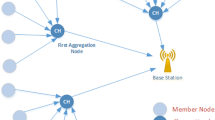Abstract
In wireless sensor network applications for surveillance and reconnaissance, large amounts of redundant sensing data are frequently generated. It is important to control these data with efficient data aggregation techniques to reduce energy consumption in the network. Several clustering methods were utilized in previous works to aggregate large amounts of data produced from sensors in target tracking applications (Park in A dissertation for Doctoral in North Carolina State University, 2006). However, such data aggregation algorithms show effectiveness only in restricted environments, while posing great problems when adapting to other various situations. To alleviate these problems, we propose two hybrid clustering based data aggregation mechanisms. The combined clustering-based data aggregation mechanism can apply multiple clustering techniques simultaneously in a single network depending on the network environment. The adaptive clustering-based data aggregation mechanism can adaptively choose a suitable clustering technique, depending on the status of the network. The proposed mechanisms can increase the data aggregation efficiency as well as improve energy efficiency and other important issues compared to previous works. Performance evaluation via mathematical analysis and simulation has been made to show the effectiveness of the proposed mechanisms.














Similar content being viewed by others
References
Park, S. J. (2006). Performance analysis of data aggregation schemes for wireless sensor networks static-cluster aggregation and dynamic-cluster aggregation section. A dissertation for Doctoral in North Carolina State University.
Rajaqopalan, R., & Varshney, P. (2006). Data-aggregation techniques in sensor networks: A survey. IEEE Communications Surveys & Tutorials, 8(4), 48–63.
Krishnamachari, B., Estrin, D., & Wicker, S. (2002). The impact of data aggregation in wireless sensor networks. In Proceedings of 22nd International Conference on Distributed Computing Systems Workshop, Vienna, Austria, July.
Intanagonwiwat, C., Govindan, R., Estrin, D., Heidemann, J., & Silva, F. (1999). Directed diffusion for wireless sensor networking. IEEE/ACM Transactions on Networking, 11(1), 2–16.
Ye, W., Heidemann, J., & Estrin, D. (2002). An energy-efficient MAC protocol for wireless sensor networks. In Proceedings of IEEE Conference on Computer Communications, New York, USA, June.
Heinzelman, W., Chandrakasan, A., & Balakrishnan, H. (2000). Energy-efficient communication protocol for wireless microsensor networks. In Proceedings of 33rd Hawaii Int’l Conference on System Sciences, Hawaii, USA, January.
Hao, X., Kang, Y., & Wang, Y. (2008). Geographical-based multihop clustering algorithm for distributed wireless sensor network. In Proceedings of 7th World Congress on Intelligent Control and Automation (WCICA), June.
Deosarkar, B., Yadav, N., & Yadav, R. (2008). LCFWSN–energy efficient layered cluster formation scheme for clusterhead life extension in wireless sensor networks. In Proceedings of 7th World Congress on Intelligent Control and Automation, Chongqing, China, June.
Jiao, Z., Fengyuan, R., Tao, H., & Chuang, L. (2009). Data aggregation basedo dynamic routing in wireless sensor networks. In Proceeding of International Conference on Communications and Mobile Computing, Yunnan, China, January.
Busse, M., Haenselmann, T., & Effelsberg, W. (2006). TECA: A topology and energy control algorithm for wireless sensor networks. In Proceedings of the 9th ACM/IEEE International Symposium on Modeling, Analysis and Simulation of Wireless and Mobile Systems, Malaga, Spain, October.
Chen, Y., & Son, S. H. (2005). A fault tolerant topology control in wireless sensor networks. In Proceedings of ACS/IEEE International Conference on Computer Systems and Applications, Cairo, Egypt, January.
Ghosh, R., & Basagni, S. (2006). Napping backbones: Energy efficient topology control for wireless sensor networks. In Proceedings of IEEE Radio and Wireless Symposium, San Diego, USA, January.
Qian, Y., Zhou, J., Qian, L., & Chen, K. (2006). Highly scalable multihop clustering algorithm for wireless sensor networks. In Proceedings of International Conference on Communications, Circuits and Systems, Guilin, China, June.
Ma, M., Zhang, Z., & Yang, Y. (2005). Multi-channel polling in multi-hop clusters of hybrid sensor networks. In Proceedings of IEEE Global Telecommunications Conference, St. Louis, USA, November.
Chen, W. P., Hou, J. C., & Sha, L. (2004). Dynamic clustering for acoustic target tracking in wireless sensor networks. IEEE Transactions on Mobile Computing, 3(3), 258–271.
Cheng, J. Y., Ruan, S., Cheng, R., & Hsu, T. (2006). PADCP: Power-aware dynamic clustering protocol for wireless sensor network. In Proceedings of IFIP International Conference on Wireless and Optical Communications Networks, Bangalore, India, April.
Kejun, D., Xingshe, Z., Xingguo, Z., & Zhigang, L. (2006). HETCP: A hierarchical energy efficient topology control protocol for wireless sensor networks. In Proceedings of IEEE Wireless Communications, Networking and Mobile Computing, Wuhan, China, September.
Scalable Networks (2010) Qualnet Web Site, Available Online: http://www.scalable-networks.com/. Accessed 31 January, 2010.
CC2420 Datasheet. Texas Instruments Web Site, Available Online: http://www.ti.com/. Accessed 31 January, 2010.
He, T., Gu, L., Luo, L., Yan, T., Stankovic, J., & Son, S. (2006). An overview of data aggregation architecture for real-time tracking with sensor networks. In Proceedings of 20 th IEEE International Parallel and Distributed Processing Symposium, Rhodes Island, Greece, April.
Bai, F., Sadagopan, N., & Helmy, A. (2003). IMPORTANT: A framework to systematically analyze the Impact of Mobility on Performance of Routing protocols for Adhoc Networks. In Proceedings of IEEE Conference on Computer Communications, San Francisco, USA, April.
Dietrich, I., & Dressler, F. (2009). On the lifetime of wireless sensor networks. ACM Transactions on Sensor Networks (TOSN), 5(1), 1–38.
Acknowledgments
Authors are grateful to the anonymous reviewers for their helpful comments. This work was partly supported by the IT R&D program of MKE/KEIT, Republic of Korea (10033886, Core technology development of large-scale, intelligent and cooperative surveillance system) and Basic Science Research Program through the National Research Foundation of Korea (NRF) funded by the Ministry of Education, Science and Technology (2011-0002438).
Author information
Authors and Affiliations
Corresponding author
Rights and permissions
About this article
Cite this article
Jung, WS., Lim, KW., Ko, YB. et al. Efficient clustering-based data aggregation techniques for wireless sensor networks. Wireless Netw 17, 1387–1400 (2011). https://doi.org/10.1007/s11276-011-0355-6
Published:
Issue Date:
DOI: https://doi.org/10.1007/s11276-011-0355-6




